Family : Tephritidae

Text © Prof. Santi Longo

English translation by Mario Beltramini
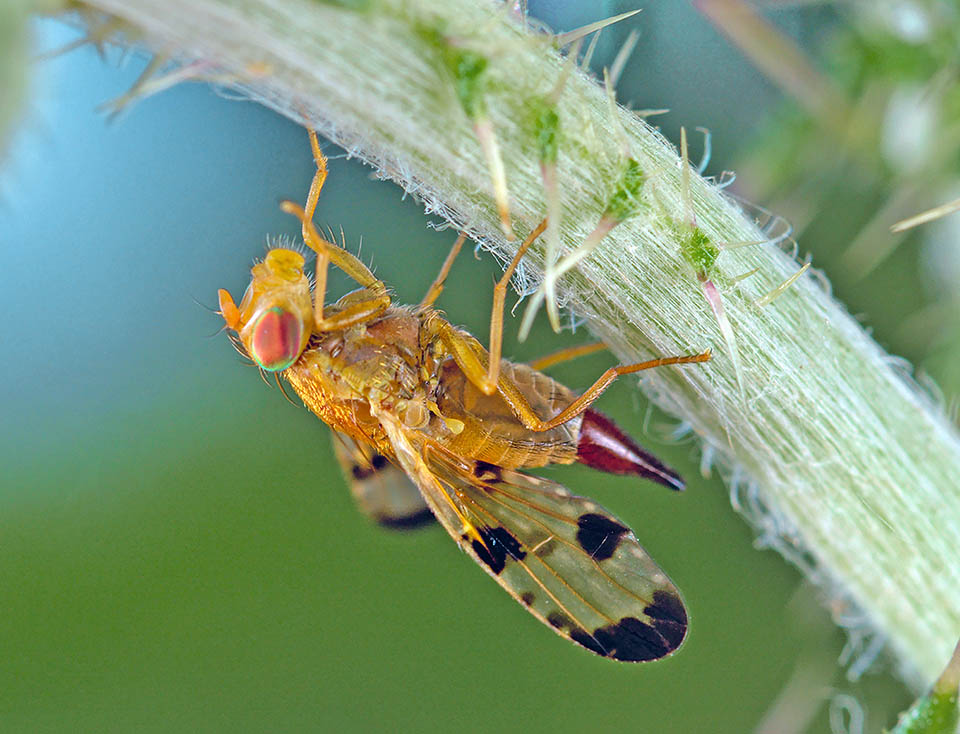
The Mottled Thistle Fly (Xyphosia miliaria) is present in most Europe, in the eastern Palaearctic area, and in Near East © Gilles San Martin
The Mottled Thistle Fly, Xyphosia miliaria (Schrank, 1781), is a Dipteran of the family Tephritidae, from the Greek “Tripe”, auger or drill, with reference to a particular type of ovipositor, called of substitution, with which the females of this species pierce the plants substrates to oviposit.
Also the name of the genus Xyphosia Robineau-Desvoldy, 1830, from the Greek “xyphos”, sword, refers to the ovipositor, whilst the specific epithet miliaria, from the Latin “miliarius”, one mile long, perhaps evokes the remarkable migrations undertaken by these insects.
To the family Tephritidae are ascribed more than 4500 species diffused in the tropical, subtropical and temperate areas of the world.
The adults have a 2 to 20 mm long body. The wings present spots useful for the identification of the species. Characteristic is the course of the subcostal rib that is usually interrupted and often gets the shape of a simple fold and fades. The anal cell is distinctly narrowed, elongated or pointed.
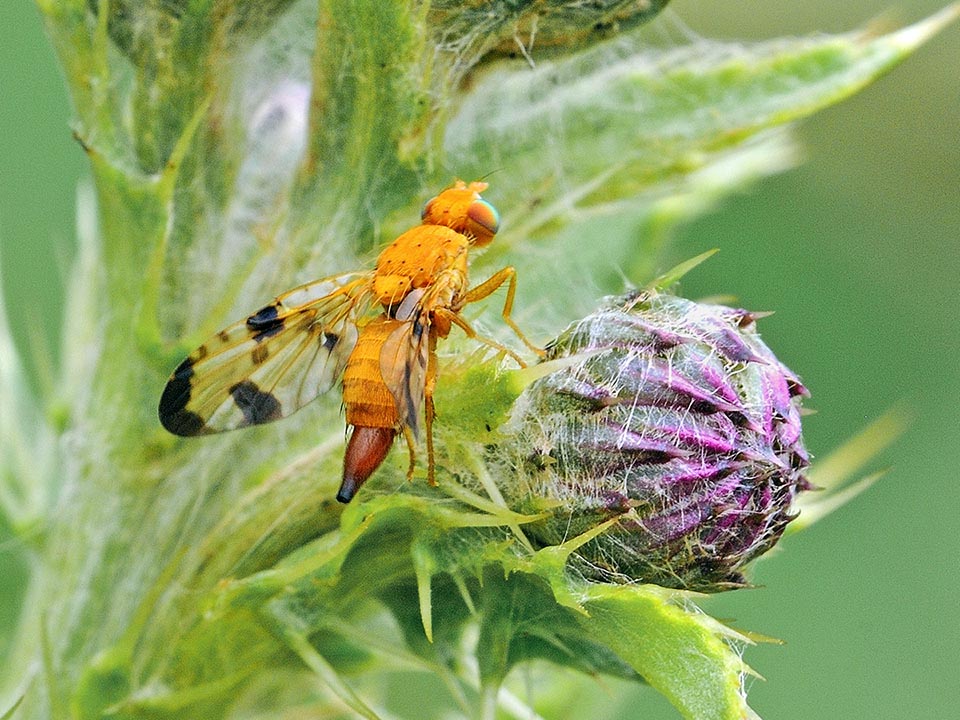
It measures 5-8 mm and females, having a particular type of ovipositor, called of substitution, parasitize the inflorescences of genera Cirsium and Carduus © Tim Worfolk
In the females the seventh segment of the abdomen is very developed and contributes to the formation of a sort of case, or oviscape, rigid and conical where is bent inwards the pointed ovipositor for the perforation of the plants tissues.
The stiletto is formed by the eighth and ninth segments of the abdomen, from which comes the old family of the family Tripetidae (from “tryps”, in Greek, I drill).
The morphology of the larval stages depends on their food specialization; the species feeding on fruits, or carpophagous, have a sub conical body, pointed in front whilst the species feeding on seeds, or spermophilous, and those that cause the formation of galls, or gallogenic, have an oval shape.
The oligophagous and monophagous, of the temperate climates, thanks to long diapauses, tend to form rather stable local populations, synchronized with the physiology of the host plants. The polyphagous species, diffused in the tropical and subtropical zones, can spend the winter in the adult stage and often perform dispersive movements covering several tens of kilometres in flight before reproducing.
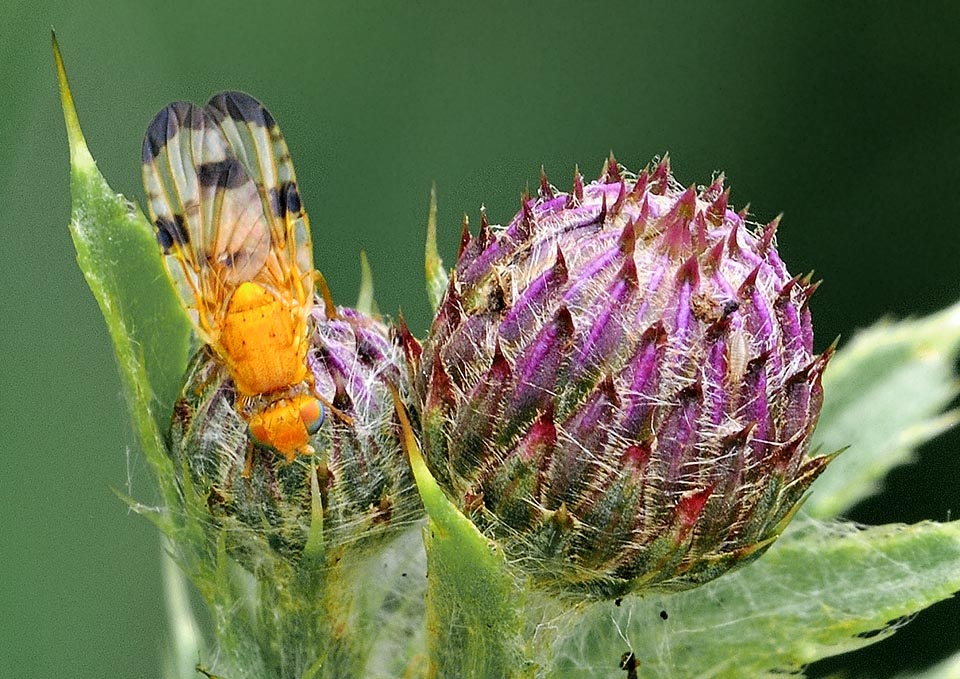
The body is orange yellow with orange red compound eyes fading to green. The bristles and characteristic dark spots on wings serve to the determination © Tim Worfolk
The most important species of economic interest of the Tephritidae are included in the genera Anastrepha, that includes Central and South-American species and of the East Indies that attack the fruits of several plants.
In the Mediterranean Basin the most harmful species belong to three genera:
- Bactrocera, with Bactrocera oleae (Rossi, 1790, the Olive fruit fly and Bactrocera dorsalis (Hendel,1914), the Oriental fruit fly, native to tropical Asia, Australia and South Pacific.
- Ceratitis of Afro-tropical origin with Ceratitis capitata Wiedemans, 1824, the Mediterranean fruit fly.
- Rhagoletis with Rhagoletis cerasi (Linnaeus, 1758), the Cherry fruit fly.
Zoogeography
Xyphosia miliaria is present in most of Europe, in the Eastern Palearctic area, in the Near East, and is common throughout the Italian Peninsula and in Sicily.
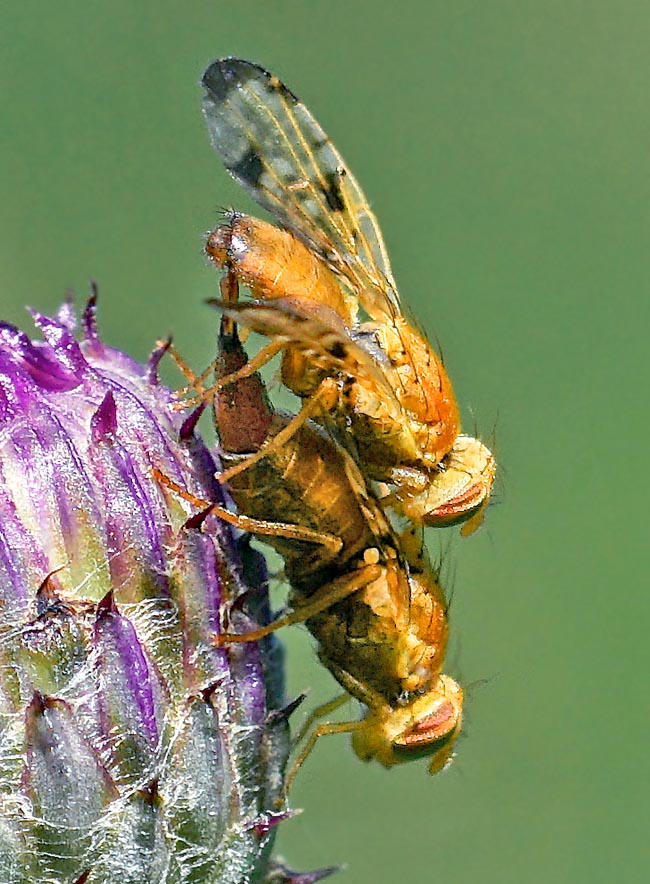
To induce the female to mating, the male gently strokes her abdomen with its forelegs © Paul Davis
Ecology-Habitat
The Mottle thisted fly is fairly frequent in the humid zones, in the meadows, in the fences and in the margins of the woods where are present host plants of the genera Cirsium and Carduus.
The larvae develop in the capitula of the Creeping thistle (Cirsium arvense), of Cirsium eriophorum, as well as on those of the Marsh thistle (Cirsium palustre), of the Spear thistle (Cirsium vulgare) and of other species of the genus Carduus.
In Australia Xyphosia miliaria has been taken into consideration as part of a biological control project against the Carduaceae that infest the pastures.
Morphophysiology
The adults measure 5 to 8 mm, their body is of orange yellow colour. On the head are present big compound eyes of orange red colour fading to bright green.
On the thorax are present rigid bristles of taxonomic interest.
The membranaceous wings have orange shades and have characteristic black spots.
The abdomen of the males is rounded and appears shorter than that of the females which is equipped with a robust ovipositor of substitution formed by the eighth segment that dorsally (urotergite) forms an unequal process and ventrally (urosternite) two more structures.
The vermiform larvae have no legs and their white body is just over 5 mm long when mature.
The pupae form inside the tegument of the third age larva, that hardens transforming in a protective case called puparium pof light brown colour, more or less dark.
Ethology-Reproductive Biology
The adults live in the warm and humid environments where they spend the winter and are active from spring to autumn on the flowers of several nectariferous and pollineforous plants that provide them with food.
The male and the female meet thanks to the emission of aphrodisiac pheromones and of a sexual allure, and the male for inducing the female to the mating strokes her abdomen with its forelegs.
The fecundated females are attracted to ovipositing by the inflorescences in bud of the Carduaceae.
During the development, with the euxinic substances present in the saliva, the larvae cause hypertrophies of the plant tissues and the forming of a gall in the capitula of the infested thistles.
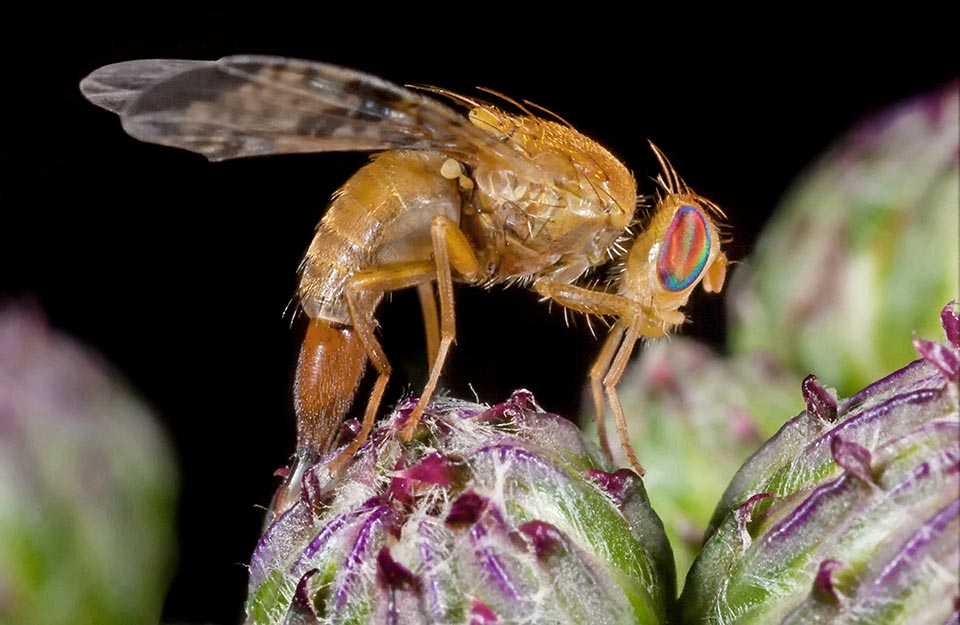
Deposition on an inflorescence. The vermiform white larvae, about 5 mm long, causes galls. When mature they create the protective case of the pupae © H. Nehr
The larval stages of the Mottled thistled fly are parasitised by the Hymenopterans of the families Ichneumonidae with Scambus buolianae (Hartig,1838); Braconidae with Bracon erraticus Wesmael,1838 and Bracon minutator (Fabricius, 1798); Pteromalidae with Pteromalus elevatus (Walker, 1834) and by various species of Torymidae of the genus Torymus.
The adults are preyed upon by Mantodea and Rhynchoctic Insects and mainly by small Spiders; from these last foes they defend keeping the wings wide open and lowered so that thanks to the spots they get the menacing appearance of another predatory spider or for driving away other females from its territory.
Synonyms
Musca miliaria Schrank, 1781; Tripeta meridionalis Costa,1854, Musca arcuata Fabricius, 1782; Trupanca shaerocephali Schrank, 1803; Xyphosia cirsiorum Robineau-Desvoidy, 1843; Oxyphora miilaria Becker,1905; Xyphosia miliaria spp. balcanica Drenskij, 1943.
